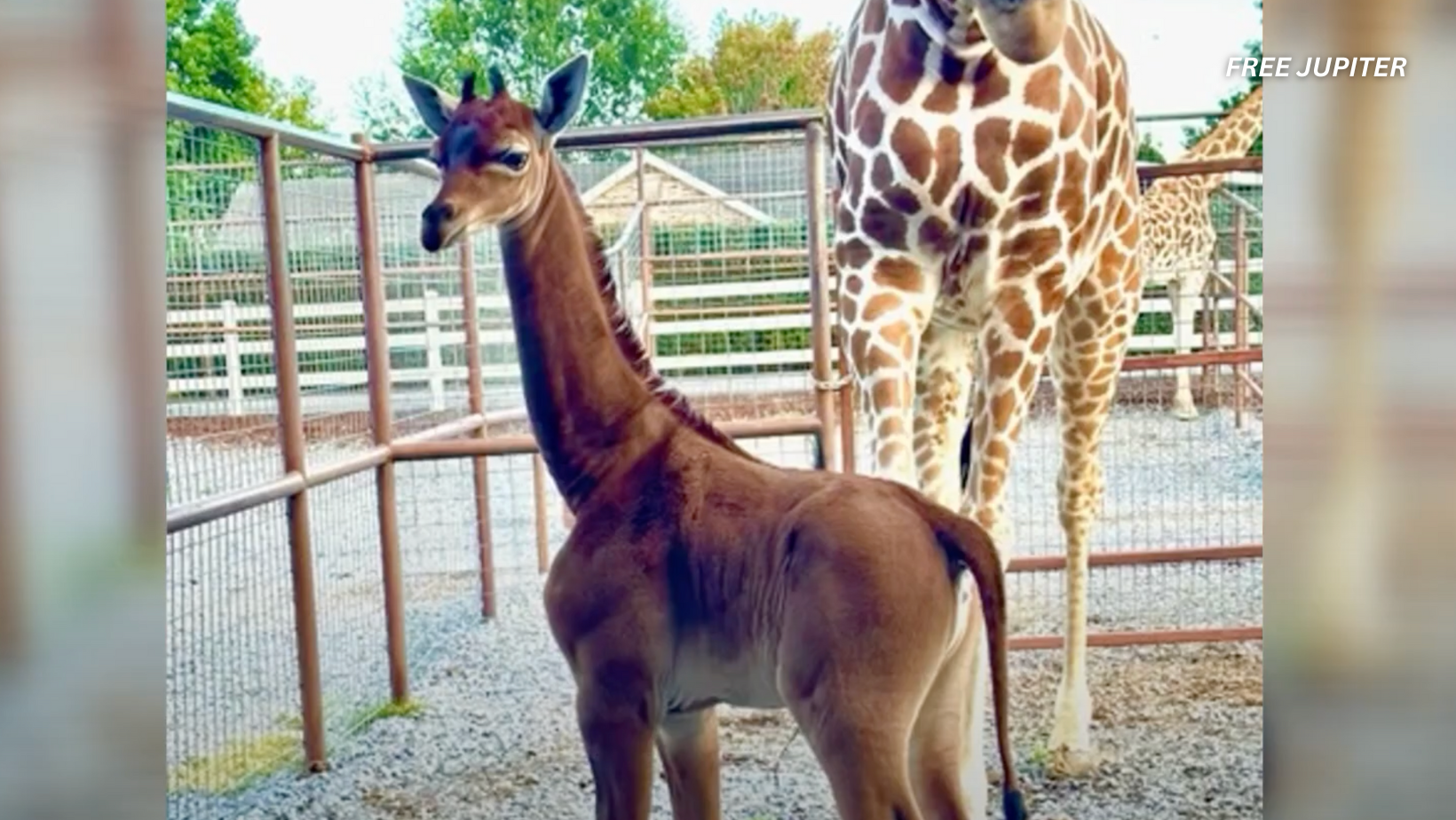Friendly Note: FreeJupiter.com shares general info for curious minds 🌟 Please fact-check all claims—and always check health matters with a professional 💙
At first glance, she might look like an ordinary giraffe calf—long legs, towering neck, curious eyes. But look closer, and something is strikingly different. Instead of the familiar patchwork of spots that most giraffes are born with, this newborn at Brights Zoo in Washington County, Tennessee, is covered in smooth, solid brown. Not a single spot in sight.
This baby captured the hearts of animal lovers around the globe. According to the zoo, she was the only known spotless reticulated giraffe at the time living anywhere in the world. Her birth is not just a charming anomaly—it’s an opportunity to spark conversation about giraffes, their survival, and their significance in the natural world.
A Giraffe Unlike Any Other
Giraffes are usually celebrated for their patchy coats, which look like a cross between a jigsaw puzzle and an abstract painting. These patterns are not random; they vary between subspecies and even serve practical purposes. But this calf is breaking the mold in every sense.
While there was a report of a spotless giraffe in Tokyo’s Ueno Zoo back in 1967, sightings like this are so rare that they’re almost considered once-in-a-lifetime events. To put it in perspective, more than 150,000 reticulated giraffes once roamed East Africa. Today, their numbers have shrunk to about 16,000 in the wild, and not one of them is known to be spotless.
So this Tennessee calf isn’t just rare—she’s possibly one of a kind.
Read more: China Discovers Gold-Filled Cave Worth $100 Billion Hidden in a Mountain
A Name Fit for a Unique Calf
Naming an animal that has already gained international attention is no small task. To involve the public, Brights Zoo launched a vote with four beautiful options, all in Swahili, a language widely spoken across East Africa—the natural home of giraffes. The choices were:
- Kipekee – “unique”
- Firyali – “unusual” or “extraordinary”
- Shakiri – “she is most beautiful”
- Jamella – “one of great beauty”
Each option highlights her rarity while honoring the cultural roots of the species. The winning name, announced in September, will forever tie her to her remarkable story.
Why Do Giraffes Have Spots Anyway?
To appreciate how unusual this calf is, it helps to understand why spots exist in the first place. Giraffe spots are more than fashion—they’re functional survival tools.
Camouflage in the Wild
In their native African savannas, spots help giraffes blend into the dappled light filtering through trees. Calves, in particular, benefit from this camouflage while hiding from predators like lions or hyenas.
Family Resemblance and Genetics
A 2018 study published in Zoological Science analyzed spot patterns in Masai giraffes. Researchers found that characteristics such as size, shape, and color are inherited, much like human fingerprints or freckles. Calves with larger, rounder spots even appeared to have better survival rates.
Built-in Cooling System
Perhaps most fascinating, each patch has a network of blood vessels underneath. This acts like a thermal window, allowing giraffes to release excess heat. In a way, their spots double as both camouflage and climate control.
This raises an intriguing question: what does it mean for a giraffe to have no spots at all? In the wild, such an absence might make survival more difficult. But in the safe environment of a zoo, the calf faces no such pressures—giving her a chance to thrive despite her unusual appearance.
Giraffes in Culture and Symbolism
Beyond their biology, giraffes have long fascinated humans. Ancient rock carvings in Africa depict giraffes, suggesting they’ve been admired for thousands of years. Their towering necks often symbolize vision, foresight, and reaching higher. In some cultures, giraffes are even associated with peace because of their calm, graceful movements.
The spotless calf adds a new layer to this symbolism. She is not only unique in appearance but also serves as a living reminder of rarity and fragility. Just as her lack of spots sets her apart, the dwindling numbers of giraffes in the wild highlight how special—and vulnerable—these creatures truly are.
The Conservation Crisis
While this calf is bringing smiles worldwide, her story also carries a sobering truth: giraffes are in trouble.
Over the past 30 years, wild giraffe populations have plummeted by about 40%. Habitat loss, poaching, and human encroachment are the primary culprits. Despite their iconic status, giraffes are sometimes referred to as the “forgotten giants” of conservation.
The Giraffe Conservation Foundation (GCF) reports that fewer than 117,000 giraffes remain in the wild across all subspecies. Some populations are now isolated, living in fragmented habitats where survival becomes increasingly difficult.
Tony Bright, founder of Brights Zoo, sees the calf’s global fame as an opportunity:
“This special giraffe’s birth is remarkable, but more importantly, it’s a chance to draw attention to the challenges her species faces in the wild.”
In other words, she may become a symbol of hope for her species—a spotted legacy carried by a spotless calf.
Read more: Nature’s First Laser Gun? Researchers Discover Peacock Feathers Emit Laser-Like Beams
Giraffes in the Digital Age: From April to Today
This isn’t the first time a giraffe has captivated the internet. Back in 2017, millions tuned in to watch April the Giraffe give birth live from a zoo in Harpursville, New York. The live stream became a global phenomenon, proving that giraffes have an undeniable charm that can cross borders and cultures.
April lived a long life, reaching 20 years before being humanely euthanized in 2021 due to arthritis. Her story drew attention to the species, just as the Tennessee calf’s story is doing today.
The difference now is that the spotlight shines not just on a giraffe giving birth, but on one born truly extraordinary.
What Makes This Birth So Special?
There are several layers to why the world is buzzing about this spotless giraffe:
- Scientific Rarity – Spotless giraffes are almost unheard of. Only one other case has been documented in modern history.
- Public Fascination – People are naturally drawn to things that break the norm. A giraffe without spots is as surprising as a zebra without stripes.
- Conservation Message – The media attention creates an invaluable platform to talk about giraffe endangerment.
- Cultural Connection – The use of Swahili names ties the calf’s story back to her ancestral roots in Africa.
A Future Ambassador
For now, the calf is thriving under the care of her mother and zoo staff. She already stands over six feet tall, with plenty of growing ahead. Giraffes can reach heights of up to 18 feet as adults, making them the tallest land animals on Earth.
Brights Zoo believes that as she grows, she can serve as a powerful ambassador for her species—bridging the gap between human fascination and real conservation action.
Her story reminds us that while uniqueness can inspire awe, it also underscores how fragile life on this planet can be. If a single spotless giraffe can grab international headlines, perhaps the plight of her entire species can finally get the attention it deserves.
Read more: Synthetic Dyes Are Out: Skittles, M&M’s, and More Go Natural by 2026
A Spotless Beginning, A Spotted Future
In the end, this Tennessee calf is more than just a curiosity—she’s a messenger. She carries with her the story of giraffes past, present, and future.
Whether her name ends up meaning “unique,” “extraordinary,” or “beautiful,” one thing is certain: she is all of those and more. And if her birth helps spark greater awareness about conservation, then this little giraffe with no spots may just leave the biggest mark of all.










